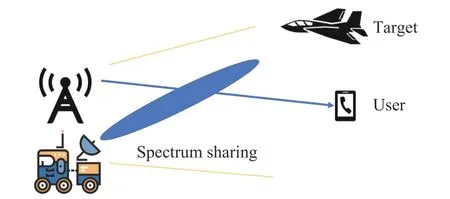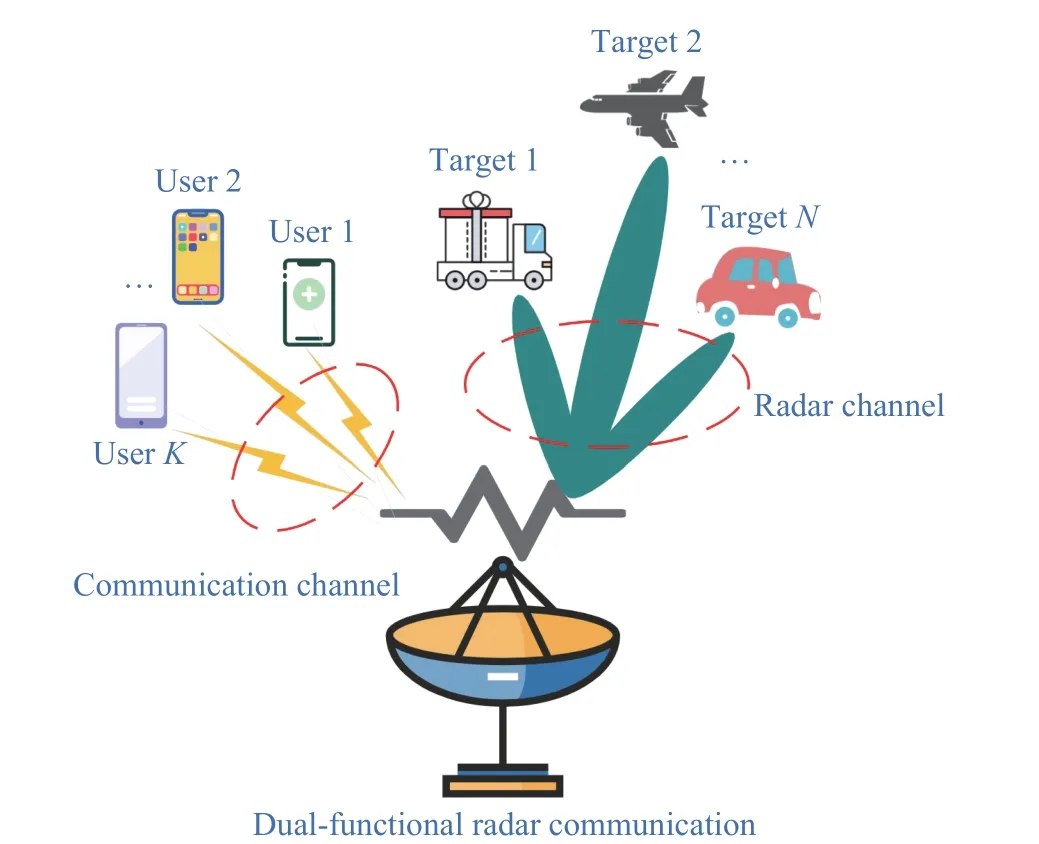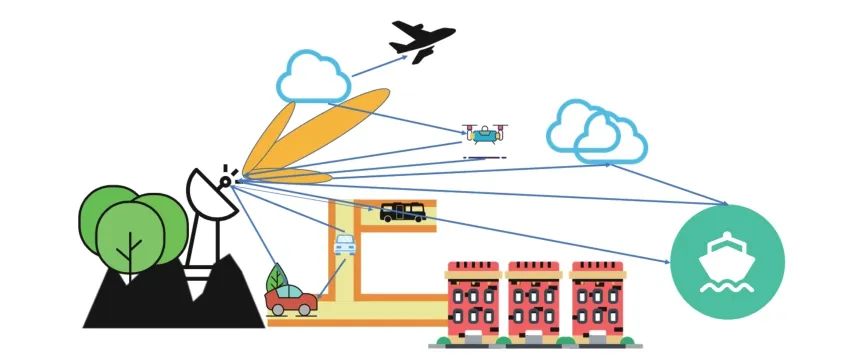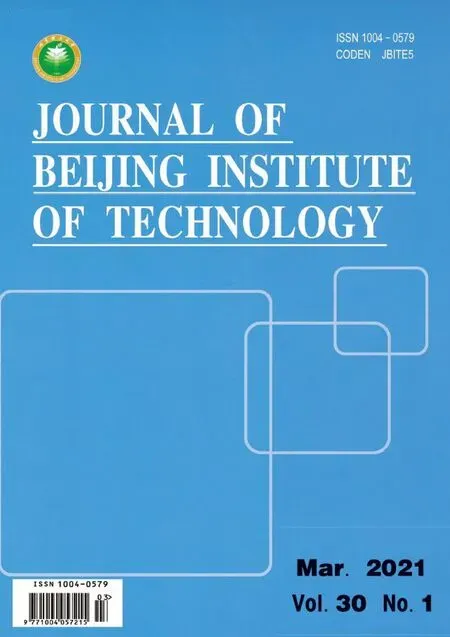A Brief Introduction on Joint Radar and Communication Systems
Jia Zhu, Fangpei Zhang, Yuanhao Cui, Junsheng Mu,Ronghui Zhang, Xiaojun Jing
Abstract: Joint radar and communication (JRC) technology is gradually becoming an essential approach to alleviating spectral congestion. Radar and communications systems were designed with common spectral and hardware resources to reduce size, improve performance, reduce cost, and decongest the spectrum. Various approaches have been proposed to achieve the coexistence of radar and communication systems. This paper mainly focuses on the research directions of radar communication coexistence (RCC) and dual-function radar communication systems (DFRC) in JRC technology. We summarize and analyze the existing research problems in the JRC era. According to the characteristics and advantages of JRC technology, we highlight several potentials in military and commercial applications.
Keywords: joint radar and communication; radar-communication coexistence; dual-functional radar communication; spectrum sharing
1 Introduction
To alleviate the contradiction between the exponential growth of wireless communication equipment and the depletion of spectrum resources,the coexistence of communication systems with other electronic devices in the same frequency band has drawn considerable attention from academics and the wireless communication industry [1].Fig. 1 shows the current competition for spectral signals among many electronic devices. Radar and communication systems operate on a shared spectrum arises several novel problems such as waveform design for joint radar and communication (JRC) system, dynamic spectrum access for radar and communication systems, and interference management [2-4]. In general, two major research trends can be defined as follows:
1) Radar-communication coexistence (RCC);
2) Dual-functional radar communication(DFRC) system.
When the radar and the communications systems operate on the same frequency band, the main problem in RCC is eliminating or mitigating the interference between the radar and communication systems while maintaining the performance of both. In [5,6], interference mitigation processing approaches were utilized to ensure the performance of multiple-input, multipleoutput(MIMO) radar system, which possessed an inherent resilience to interference. As shown in Fig. 2, radar and communication systems work in the same frequency band without affecting their respective functions.
Considering the hardware integration of radar and communication transmitters, DFRC jointly designs signal processing strategies to balance both radar and communication systems’performance. One of the DFRC approach’s overall goals is to allow communication services to leverage the resources of the radar infrastructure while striving to be transparent to radar operations and missions.

Fig. 1 The current state of spectrum resources

Fig. 2 Radar-communication coexistence
RCC techniques often require periodic information exchange between radar and communication systems for mutual benefits. DFRC is a technology in which radar and communication systems work on a common transmit/receive aperture, common spectral waveforms, and codesign waveforms. Fig. 3 shows the capabilities of DFRC, which simultaneously carries out wireless communication and radar sensing.

Fig. 3 Dual-functional radar communication
In summary, this paper first introduces the main research issues in the JRC era, then provides the latest coexistence methods from signal processing, and finally analyzes the possible military and commercial applications of JRC technology.
2 Main Research Issues
The main research issues in RCC and DFRC are analyzed in this section.
2.1 RCC
2.1.1 Anti-Interference Design Receiver
In a scenario where radar and communication spectrum coexist, the receiver may receive both radar echo and communication signals, which is likely to cause interference problems. The two signals in the same frequency band need to be separated and then suppressed against the interference signal to solve this problem[7]. For example, in order to ensure the communication function, we need to suppress the radar echo/scatter signal received by the communication receiver, so as to reduce its interference to the communication signal and facilitate demodulation; Similarly, when radar function needs to be prioritized, it is necessary to identify and suppress the communication signal received by radar receiver, for better distinguishing the target echo.
2.1.2 Interference Channel Estimation
To eliminate the interference between radar and communication systems, it is necessary to estimate the interference channel. Uncoordinated systems of RCC make the traditional channel estimation strategy not applicable here. Therefore, we need to find an interference channel estimation method suitable for the coexistence of radar communication. Besides, radar systems often have high security and secrecy requirements, which requires us to consider non-cooperative channel estimation methods when implementing the interference channel estimation of radar communication systems[7].
2.2 DFRC
DFRC means the two systems work on one platform and share the same spectral resources and hardware. Those systems use the same radar aperture and frequency bandwidth to enable communication data to be transmitted efficiently,either as waveform parameters and target information or as information independent of radar operation. The Shannon theory lays the foundation of wireless communication, but the information theory involved in DFRC has not been thoroughly studied. To sum up, DFRC issue may be analyzed from three aspects.
2.2.1 Improved Information Theory
Obviously, there is a fundamental difference in the way radar and communication systems work.We use different performance indicators to evaluate the radar’s detection capability; for example,the target detection performance is characterized by probability/false alarm probability, and the optimal lower bound of the target parameter estimation variance is given by the Cramer-Rao lower bound (CRLB). In [8], a novel approach named the radar estimate information rate was proposed to evaluate the JRC performance bounds. The authors present the multiple access communication performances bound as an analogy to the bounds on the JRC system’s performance. Several inner bounds on the JRC system’s performance have been proposed by considering different scenarios, in which the estimation data rates are considered for the radar and communications systems, respectively. This method is of great importance in completing information theory.
2.2.2 Signal Processing
The signal processing of JRC systems includes waveform design, beamforming technology, and others. Integrated signal processing can be classified as radar-centric, communication-centric, and collaborative design by the functional priority [9].
2.2.3 DFRC Protocol and System Design [7]
Communication systems can be classified into many types, such as frequency-division multiplexing (FDM), time-division multiplexing(TDM) and code-division multiplexing (CDM),where the working mode of the radar can be simply divided into pulse radar and continuous wave radar. New transmission protocols and system architectures need to meet the integration of radar and communication systems and achieve the purpose of noninterference and cooperative transmission in JRC techniques. Therefore, it is necessary to design a low-cost, low-complexity,and high-efficiency DFRC system architecture.
3 Recent Methods
This section discusses the recent work on JRC techniques according to two categories: RCC and DFRC. We review detailed research methods in recent years, which will help to understand JRC technology better. We will first present approaches for RCC, and then introduce the system design methods of DFRC.
3.1 RCC
Opportunistic spectrum sharing is an extension of cognitive radio, which requires secondary users to sense the spectrum and then transmit data when the spectrum is not occupied [10]. In [11], a rotating scanning radar’s coexistence in a cellular communication system was investigated. In the proposed model in [11], the radar antenna’s main lobe rotates continuously while the communication system communicates when it is in the radar side lobe. Under the limited signal-to-interference plus noise ratio (SINR), the minimum distance between the radar and the base station is calculated. The downlink communication rate under opportunistic spectrum sharing and the possibility of various data transmission services is analyzed. Additionally, a mathematical model for radar performance under cellular jamming conditions is established in [12].
To solve the problem of interference channel estimation, [13] proposes a control center between the radar and the communication system to coordinate the estimation of interference channel state information and carry out precoding design. Due to the high cost of the control center, it is proposed in [14] that the detection signal of the MIMO radar is used as the pilot frequency, and that the base station judges the operating mode of the radar according to the hypothesis testing method to estimate the interference channel. In [15], the composite rate of the radar wave degree of freedom and communication symbol coding matrix is optimized under SINR and power constraints. The precoder’s joint design proposed in [16] solves the SINR maximization problem of the JRC system.
In [17], the covariance matrix of communication signals and the subsampling matrix of the radar are jointly optimized to minimize the equivalent interference power of the radar terminal after sampling the received signals and to meet the transmitting power and capacity constraints of the communication system at the same time.To further realize the shared spectrum between a MIMO radar and multiuser MIMO communication system (MU-MIMO), a robust precoding scheme under the assumption of imperfect Interference Channel State Information (ICSI) is proposed in [18]. This scheme maximizes the detection probability of the radar and ensures the SINR constraints of downlink communication users.
The receiver needs to either demodulate the communication signal or estimate the radar target in the presence of radar jamming. [19] first considers the design of a communication receiver in the case of noncooperation between a radar and communication system. [20] considers the design problems of a communication receiver when the amplitude of the radar interference signal is known and the phase is unknown, in addition to discussing how to determine the optimal decision domain according to the maximum likelihood criterion and design the adaptive optimal constellation to minimize the symbol error rate of communication under the given communication constellation.
3.2 DFRC
The cooperation performance of DFRC will be subject to the characteristics of both subsystems.To research the integrated radar communication system’s performance limit, it is necessary to discuss the two systems’ performance measurements under the unified theoretical framework.In [21], Guerci et al. proposed that each resolution unit could be regarded as a “constellation point” to measure the “rate” of radar acquiring target information. Furthermore, in [22], a radar communication integrated receiver was considered with the capacity of processing the radar echo and the uplink signal of the communication user simultaneously, which can be regarded as a special multiple access channel. [23] presented a weighted spectral efficiency, which was used as a comprehensive performance measure of the integrated system by weighing the integrated system’s radar and communication functions. [24] analyzed an integrated multiantenna system and defined its estimated rate.
One of JRC systems’ critical problems is integrated waveform design, or designing a new multiplexed waveform that can not only carry communication information but also be used for radar target detection. Research on radar communication integrated waveform design has experienced three stages: linear frequency modulation (LFM) integrated waveform design, orthogonal frequency division multiplexing (OFDM)integrated waveform design, and MIMO integrated waveform design. [25] analyzed the factors that need to be considered in waveform design,including waveform type, waveform index, bandwidth, waveform diversity, ambiguity function.Liu et al. [26] used minimum shift keying (MSK)modulated LFM to design the integrated waveform. Compared with that of a traditional LFM signal, the ambiguity function of the MSK-LFM signal has a better range and accuracy for measuring velocity. Based on the idea of OFDM, [27]proposes an orthogonal frequency division LFM(OFD-LFM) signal to realize the loading of multiple communication codes of a single LFM pulse and improve the data transmission rate.
The JRC waveform with OFDM technology has a lower side lobe, a higher Doppler tolerance,and an improved information transmission ability. Therefore, much research has been carried out on the application of OFDM in radar systems. [28] found that while the performance characteristics can be retained, the range-Doppler fuzziness of OFDM radar is, to some extent, better than that of traditional LFM radar. Wang et al. [29] added a chirp signal into the traditional OFDM subcarrier signal and compared the traditional OFDM signal with the same frequency for each subcarrier to see where its performance peak-to-average power ratio (PAPR) could be effectively improved. For the OFDM integrated waveform ambiguity function’s optimization design, [30] used the method of least-squares to synthesize the OFDM coded signal ambiguity function to obtain the pin-shaped ambiguity and function. An iterative phase allocation algorithm was designed to select the appropriate codes to synthesize OFDM signals for the sidelobe reduction of the ambiguity function. John et al. [31, 32]proposed a multicarrier phase carrier (MCPC)sequence optimization algorithm based on gray code coding to reduce the designed waveform autocorrelation function’s sidelobe level.
Compared with conventional system radar and phased array radar, MIMO radar has unique advantages of spatial diversity and waveform diversity, and also has great potential in mitigating fading, improving resolution, and suppressing interference. [33] proposed a scheme for transmitting communication information by phase modulation in MIMO radar. [34] used the convex optimization method to design the MIMO integrated signal so that the radar signal and the communication signal could be transmitted to a specified angle while minimizing the transmitting power. [35] discussed the integrated beamforming of MIMO radar and MU-MIMO communication systems in non-line-of-sight channels.Among them, the communication signal is directly used for radar detection. Because a communication symbol represents a fast radar time sampling point, it will not affect the downlink communication rate.
4 Application Scenarios
JRC is a promising technology that provides sensing and communication capabilities for various electronic devices, as depicted in Fig. 4. In the following section, we describe existing or potential applications of JRC from both commercial and military perspectives.

Fig. 4 A promising scenario of JRC
4.1 Commercial Use
Commercial users see JRC as a promotion of advanced technology and have recently received attention. Typical scenarios include autopilot,drone sense and communication, and air traffic management system.
4.1.1 Autopilot
Self-driving vehicles have very high requirements for data transmission delay, usually within 10 ms,which is not available in general communication systems. At present, automotive positioning and vehicle-to-everything(V2X) functions, such as dedicated short-range communication (DSRC)technology [36] and LTE-advanced (LTE-A)technology [37], can provide the essential functions necessary for vehicle networking but do not meet the technical norm required for autonomous driving. 5G technology combined with a large-scale MIMO antenna array can achieve the positioning and communication requirements of V2X [38]. Radar target echoes in mm-wave channels receive much less clutter than the sub-6 GHz band, making them very useful for vehicle positioning [39].
4.1.2 Drone Sense and Communication
Drones, such as those used in geographic exploration, emergency communication, and logistics transportation, are increasingly needed [40].Drones not only detect environmental data in these scenarios but also transmit it to the user.In these scenarios, a large amount of data is transmitted. Radars on drones can be used to support drone cluster formations and collision detection [41]. Simultaneously, drones can be used for destructive purposes as drones from an enemy could pose a threat to our infrastructure and personnel [42]. To address this situation, drone surveillance radar was developed, but it was expensive [43]. JRC technology can reduce costs and make unmanned aerial vehicles (UAVs),such as drones, more integrated.
4.1.3 Air Traffic Management System
The aviation industry’s vigorous development has led to the continuous progress of commercial aircraft navigation and air traffic control (ATC)technology [44]. Automatic-dependent surveillance-broadcast (ADS-B) based on JRC technology is a promising application in the civil aviation industry. Civil airliners use ADS-B to broadcast their flight parameters to ensure that they can be tracked by nearby ground towers or airliners[45]. JRC surveillance technology can simplify the deployment and reduce costs. For instance, the L-band digital aeronautical communication system type (LDACS1) has been utilized as a signal of opportunity for passive MIMO radar implementation [46]. In [47], the Air Force Research Laboratory (AFRL) tested multifunctional waveforms on the software-defined radar.In addition, traffic collision avoidance (TCAS)has also developed significantly from JRC technology.
There are also some potential radar communication integration applications, such as radio frequency identification (RFID) [48], medical sensors [49], and radar serving as communication relays [50].
4.2 Military Use
Military equipment is moving toward multifunctional integration to adapt to future forms of warfare and improve the probability of survival[51]. Different weapon platforms are equipped with a variety of electronic devices leading to more serious electromagnetic interference between various weapons. We give two typical examples of JRC military application scenarios:
4.2.1 Automatic Target Recognition
Automatic target recognition (ATR) is an algorithm used to identify a target based on the data acquired by sensors. The sensors in ATR systems include radar, sonar, infrared cameras,etc. ATR requires real-time environmental sensing and rapid information interaction to achieve target discovery. Therefore, JRC technology applied to ATR systems could make the equipment smaller, improve the detection ability, and enhance the equipment’s communication ability.
4.2.2 Military Electromagnetic System
The growth of shipborne and airborne radio frequency (RF) systems results in a significant increase in the combat platform’s amount of antennas and weight. Besides, the size of the antenna array increases. For example, the increasing radar and communication subsystems on vessels have made antennas highly congested on decks and bridges. A wide variety of airborne equipment makes the aircraft larger and affects its endurance. Moreover, electromagnetic interference and compatibility problems inevitably arise between these devices. Therefore, technical solutions for the integration of this equipment are particularly urgent. JRC technology allows both shipborne and airborne radar and communications subsystems to be integrated into one. This will significantly mitigate electromagnetic interference between them and reduce the radar crosssection (RCS).
For the sake of clarity, we summarize the above JRC technology application scenarios in Tab. 1 and list some potential scenarios that are not described in detail in this survey.

Tab. 1 Applications of the JRC technology
5 Conclusion
Due to the scarcity of spectrum resources, JRC technologies have become a primary investigation field in recent years. Many methods have been proposed to solve the problem of spectra and function coexistence in JRC technologies. In this paper, we introduce some representative methods and analyze the main research problems of JRC systems in detail. We also propose possible military and commercial applications.
 Journal of Beijing Institute of Technology2021年1期
Journal of Beijing Institute of Technology2021年1期
- Journal of Beijing Institute of Technology的其它文章
- MIMO Radar Waveform Design: An Overview
- Pattern Synthesis via Accurate Array Response Control: An Overview
- QoS-Aware Power Allocation Scheme for Relay Satellite Networks
- System Design and Signal Processing for Frequency Diverse Array Radar
- A New Transmit Beamforming Method for Multi-User Communication in Dual-Function Radar-Communication
- Dual-Use Signal Design for Radar and Communication via Joint Orthogonal Signal and Phase Modulation
